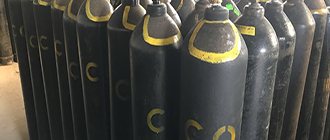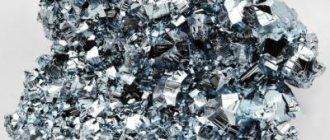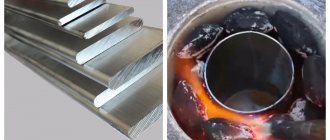Definition and use of density
As you know, to find the density of a substance, its mass is divided by its volume.
Density is a physical and chemical characteristic of a substance. She is constant. Materials for industrial production must meet this indicator. To denote it, it is customary to use the Greek letter ρ. The density of iron is 7874 kg/m³, nickel - 8910 kg/m³, chromium - 7190 kg/m³, tungsten - 19250 kg/m³. Of course, this applies to hard alloys. In the molten state, substances have different characteristics.
In nature, only some metals are present in large quantities. The specific gravity of iron in the earth's crust is 4.6%, aluminum - 8.9%, magnesium - 2.1%, titanium - 0.63%. Metals are indispensable in most areas of human activity. Their production is growing year by year. For convenience, metals are divided into groups.
Iron and its alloys
Ferrous metals are usually called steel and cast iron of various grades. An alloy of iron and carbon is considered steel if the iron content is at least 45% and the carbon content is 0.1%-2.14%. Cast iron, accordingly, contains more carbon.
To obtain the necessary properties of steels and alloys, they are alloyed (alloying additives are added during remelting). This is how the specified grades are melted. All metal grades strictly comply with certain technical conditions. The properties of each brand are regulated by state standards.
Depending on the composition, the density of steel varies in the range of 7.6–8.8 (g/cm³) in the SGS or 7600–8800 (kg/m³) in the SI (this can be seen from Table 1). Of course, steel has a complex structure; it is not a mixture of different substances. However, the presence of these substances and their compounds changes properties, in particular density. Therefore, high-speed steels with a high tungsten content have the highest densities.
Non-ferrous metals and their alloys
Products made of bronze, brass, copper, aluminum are widely used in production:
- Bronzes are usually alloys of copper with tin, aluminum, lead and beryllium. However, in the Bronze Age, when the proportion of bronze in the total mass of metal products was almost 100%, these were copper-arsenic alloys.
- Zinc-based alloys - brass. Brass may contain tin, but its amount is less than zinc. Lead is sometimes added to produce free-flowing chips. In addition to jewelry alloys of brass and bronze, they are needed for machine and marine parts, hardware, and springs. Some varieties are used in aviation and rocketry.
- Duralumin (duralumin) - an alloy of aluminum and copper (copper 4.4%) is a high-strength alloy. Mainly used in aviation.
- Titanium is stronger than many steel grades. At the same time it is twice as light. These qualities have made it indispensable in most industries. It is also widely used in medicine (prosthetics). The share of titanium in the production of aircraft reaches 70% of all smelted in the world. About 15% of titanium is used for chemical engineering.
- Silver and gold are the first metals with which man became acquainted. Throughout the history of mankind, these metals have mostly been used for jewelry. And currently the trend continues.
- Due to its high refractoriness, tungsten is indispensable in instrument making. Its high density allows it to be used as radiation protection.
- Nickel and chromium form nichrome - a heat-resistant plastic alloy, very durable and reliable.
Different grades of steel and cast iron, bronze and other metals have different chemical compositions and different densities. The densities of all required materials are measured and systematized. Tables containing this data are available to users. With their help, you can easily find the mass of a product of a given shape.
Dependence of density on temperature [edit | edit code ]
As a rule, as the temperature decreases, the density increases, although there are substances whose density behaves differently in a certain temperature range, for example, water, bronze and cast iron. Thus, the density of water has a maximum value at 4 °C and decreases both with increasing and decreasing temperature relative to this value.
When the state of aggregation changes, the density of a substance changes abruptly: the density increases during the transition from a gaseous state to a liquid and when the liquid solidifies. Water, silicon, bismuth and some other substances are exceptions to this rule, since their density decreases when solidified.
Determination of product mass
All modern reference materials, GOST and technical specifications of enterprises have been adjusted in accordance with the international classification.
Using reference tables of densities of various materials, it is easy to determine their mass. This is especially true when items are heavy or appropriate scales are not available. To do this, you need to know their geometric parameters. Most often, you need to find out the mass of an object in the form of a cylinder, pipe or parallelepiped:
- Metal rods are cylindrical in shape. Knowing the diameter and length, it is easy to find out the mass. Mass equals density times volume. Finding the volume of an object. It is obtained by multiplying the cross-sectional area by the length. The area of a circle, knowing the diameter, is easy to determine. The squared diameter is multiplied by 3.14 (pi), divided by 4.
- We obtain the mass of the pipe in the same way. When finding the area, we take the difference between the outer and inner diameter of the section.
- To determine the mass of a sheet, bloom, slab or bar of rectangular cross-section, we determine the volume by multiplying the length, height and thickness. Multiply by the density from the reference book.
With such calculations, a small error is always allowed, because the shapes are not ideal. In practice it can be neglected. Manufacturers of metal products have developed special mass calculators for users. It is enough to enter unique dimensions in the appropriate windows and get the result.
Densities of astronomical objects [edit | edit code ]
- For the average densities of the celestial bodies of the Solar System, see the inset.
- The interplanetary medium in the Solar System is quite heterogeneous and can change over time, its density in the vicinity of the Earth
10 −21 ÷10 −20 kg/m³. Density of the interstellar medium
10 −23 ÷10 −21 kg/m³.
- The density of the intergalactic medium is 2×10 −34 ÷5×10 −34 kg/m³.
- The average density of red giants is many orders of magnitude lower due to the fact that their radius is hundreds of times larger than that of the Sun.
- Density of white dwarfs 10 8 ÷10 12 kg/m³
- The density of neutron stars is of the order of 10 17 ÷10 18 kg/m³.
- The average (by volume under the event horizon) density of a black hole depends on its mass and is expressed by the formula:
ρ = 3 c 6 32 π M 2 G 3 . ho =<3,c^<6>><32pi M^<2>G^<3>>>.>The average density falls in inverse proportion to the square of the black hole mass (ρ
M −2 ). So, if a black hole with a mass on the order of the solar mass has a density of about 10 19 kg/m³, exceeding the nuclear density (2 × 10 17 kg/m³), then a supermassive black hole with a mass of 10 9 solar masses (the existence of such black holes is assumed in quasars ) has an average density of about 20 kg/m³, which is significantly less than the density of water (1000 kg/m³).
Read also: How to properly store rechargeable batteries
What is specific gravity
Specific gravity is the density multiplied by the acceleration of gravity (gravity) or the ratio of the weight of a body to its volume. It is unacceptable to confuse it with density. However, this often occurs due to confusion between the concepts of mass and weight. The weight of a body, and therefore its specific gravity, changes depending on the force of gravity. It is not a constant value. Depending on the place where the item is located, it has different meanings. This physical quantity will be different even at different points on the Earth. The acceleration of gravity at the equator is greater than at the poles. Mass and density are constant.
For example, you can calculate the specific gravity of silver. On Earth, this value will be 10,500 kg/m³ (density of pure metal). Multiplying by 9.81 m/s2 (gravity), you can get 103005 N/m³. And on the Moon, 10,500 kg/m³ is multiplied by 1.62 m/s2 (gravity on the Moon). The result is different - 17.01 N/m³. In the cabin of a ship rotating around the Earth there is weightlessness and acceleration is zero. Consequently, the weight of any material here is zero.
All values will be different. The greatest value will be in the first case, because on Earth the acceleration of gravity has the greatest significance. In zero gravity, a thing weighs nothing. The density of the same material will be the same anywhere. It is a constant.
In order to create tables of the specific gravity of metals on various planets (or in other conditions), it is necessary to know the acceleration of gravity and density.
Range of densities in nature [ edit | edit code ]
For various natural objects, density varies over a very wide range.
- The intergalactic medium has the lowest density (2·10−31 -5·10−31 kg/m³, excluding dark matter) [3].
- The density of the interstellar medium is approximately 10 −23 —10 −21 kg/m³.
- The average density of red giants within their photospheres is much less than that of the Sun - due to the fact that their radius is hundreds of times larger for a comparable mass.
- The density of hydrogen gas (the lightest gas) under normal conditions is 0.0899 kg/m³.
- The density of dry air under normal conditions is 1.293 kg/m³.
- One of the heaviest gases, tungsten hexafluoride, is approximately 10 times heavier than air (12.9 kg/m³ at +20 °C)
- Liquid hydrogen at atmospheric pressure and a temperature of −253 °C has a density of 70 kg/m³.
- The density of liquid helium at atmospheric pressure is 130 kg/m³.
- The average density of the human body is from 940-990 kg/m³ with a full inhalation, to 1010-1070 kg/m³ with a full exhalation.
- The density of fresh water at 4 °C is 1000 kg/m³.
- The average density of the Sun within the photosphere is about 1410 kg/m³, approximately 1.4 times higher than the density of water.
- Granite has a density of 2600 kg/m³.
- The average density of the Earth is 5520 kg/m³.
- The density of iron is 7874 kg/m³.
- The density of metallic uranium is 19100 kg/m³.
- The density of atomic nuclei is approximately 2·10 17 kg/m³.
- Theoretically, the upper limit of density according to modern physical concepts is the Planck density of 5.1⋅10 96 kg/m³.
Transportation of metal products
In the cargo transportation system, such a concept as “volumetric weight” is involved. If the mass of an object in one cubic meter is 167 kg, then this weight is considered physical, and if it is less, it is considered volumetric. For example, the mass of a cube of carbon steel is 7750 kg. In other words, the volumetric weight of steel is 7750 kg. These calculations are needed to determine how much volume the transported cargo will occupy.
However, depending on what metal products are transported, the volume will vary. Let's assume that there are several different hardware of the same grade of steel. In theory, they have the same density. However, ingots, large-grade products and coils of wire have different volumes, and therefore, when transported, they will take up more or less space in transport. Thus, they have different volumetric weights. Under any conditions, a cubic meter of steel is more than 167 kg, therefore, it cannot be called volumetric.
Metal Density Table
The density of metals is determined by two main factors:
- The type of crystal lattice and interatomic distances in it.
- The mass of an atom of a chemical element.
A table of densities of metals and other elements is given below.
The numbers given here are in g/cm3. In order for the table to express the density of metals in kg/m3, it is necessary to multiply the corresponding value by 1000. The table shows that metals have very different densities. They can be lighter than water (sodium, lithium, potassium) or very heavy (iridium, osmium, platinum, gold).
Gold - 19.29 g/cm³
The gold content in the ground is very low, although there are many deposits rich in it. There is even a little gold in water - in every cubic meter there is at least five micrograms of gold.
Under normal conditions, it does not oxidize and does not interact with most acids, therefore it is considered a noble metal.
Gold easily transmits heat and electricity, making it indispensable in radio electronics.
Density of some types of wood [ edit | edit code ]
Wood density, g/cm³
| Balsa | 0,15 | Siberian fir | 0,39 |
| Sequoia evergreen | 0,41 | Spruce | 0,45 |
| Willow | 0,46 | Alder | 0,49 |
| Aspen | 0,51 | Pine | 0,52 |
| Linden | 0,53 | horse chestnut | 0,56 |
| Edible chestnut | 0,59 | Cypress | 0,60 |
| Bird cherry | 0,61 | Hazel | 0,63 |
| Walnut | 0,64 | Birch | 0,65 |
| Cherry | 0,66 | Smooth elm | 0,66 |
| Larch | 0,66 | Field maple | 0,67 |
| Teak | 0,67 | Beech | 0,68 |
| Pear | 0,69 | Oak | 0,69 |
| Switenia (Mahogany) | 0,70 | Sycamore | 0,70 |
| Zhoster (buckthorn) | 0,71 | Yew | 0,75 |
| Ash | 0,75 | Plum | 0,80 |
| Lilac | 0,80 | Hawthorn | 0,80 |
| Pecan (cariah) | 0,83 | Sandalwood | 0,90 |
| Boxwood | 0,96 | Ebony | 1,08 |
| Quebracho | 1,21 | Lignum vitae | 1,28 |
| Cork | 0,20 |
Densities of some gases [edit | edit code ]
Density of gases, kg/m³ at low pressure.
| Nitrogen | 1,250 | Oxygen | 1,429 |
| Ammonia | 0,771 | Krypton | 3,743 |
| Argon | 1,784 | Xenon | 5,851 |
| Hydrogen | 0,090 | Methane | 0,717 |
| Water vapor (100 °C) | 0,598 | Neon | 0,900 |
| Air | 1,293 | Radon | 9,81 |
| Tungsten hexafluoride | 12,9 | Carbon dioxide | 1,977 |
| Helium | 0,178 | Chlorine | 3,164 |
| Dician | 2,38 | Ethylene | 1,260 |
To calculate the density of an arbitrary ideal gas under arbitrary conditions, you can use the formula derived from the equation of state of an ideal gas: [7]
ρ = p MRT ho =>> ,
Tantalum - 16.67 g/cm³
Extremely refractory (melting point 3017 °C), tantalum successfully replaces platinum in many cases.
It is used in jewelry - watch cases, bracelets and other jewelry are made from it. This is facilitated by the high hardness of the metal. In addition, it is cheaper than platinum, although more expensive than silver.
Its compounds replace platinum as catalysts in the chemical industry. In glassmaking, the addition of this metal to the melt makes it possible to obtain glasses used for the production of small binoculars and lightweight glasses. And tantalum is absolutely irreplaceable in the production of radio electronics.
Platinum - 21.40 g/cm³
The name platinum was invented by the conquistadors. Literally from Spanish it means “silver”. This disparaging name is explained by the special refractoriness of the metal. For many years they did not know how to use it; then platinum cost half as much as silver.
Nowadays it is valued much more than even gold. Extreme refractoriness, chemical inertness and excellent properties as a catalyst for chemical reactions make it indispensable in industry. At the same time, high cost and good strength open up ways for use in jewelry.
Densities of some liquids [edit | edit code ]
Density of liquids, kg/m³
| Petrol | 710 | Milk | 1040 |
| Water (4 °C) | 1000 | Mercury (0 °C) | 13600 |
| Kerosene | 820 | Diethyl ether | 714 |
| Glycerol | 1260 | Ethanol | 789 |
| Sea water | 1030 | Turpentine | 860 |
| Olive oil | 920 | Acetone | 792 |
| Motor oil | 910 | Sulfuric acid | 1835 |
| Oil | 550—1050 | Liquid hydrogen (−253 °C) | 70 |









